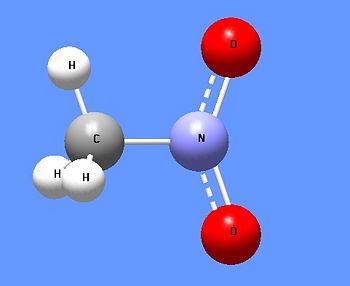Nitromethane: Difference between revisions
imported>David E. Volk mNo edit summary |
mNo edit summary |
||
| (4 intermediate revisions by 4 users not shown) | |||
| Line 1: | Line 1: | ||
{{subpages}} | {{subpages}} | ||
{{Image|Nitromethane DEVolk.jpg|right|350px|Nitromethane. The dashed lines indicate the resonance between two structures in which one or the other of the oxygen atoms forms a double bond with the nitrogen atom.}} | |||
'''Nitromethane''', also called '''Nitrocarbol''' (CH<sub>3</sub>NO<sub>2</sub>), a shock- | '''Nitromethane''', also called '''Nitrocarbol''' (CH<sub>3</sub>NO<sub>2</sub>), a shock-sensitive and thermally unstable compound, is a compound in which a single proton of methane has been replaced with the nitro group, NO<sub>2</sub>. It can be used to make biologically important nitro compounds. For example, the deprotonated anionic form, H<sub>2</sub>C=NO<sub>2</sub><sup>-</sup>, will condense with aldehydes. It also forms dangerous shock-sensitive explosive mixtures with some compounds, such as amines and acids. ''Extreme care should be taken when storing and working with nitromethane''. | ||
== | == Physical properties == | ||
Nitromethane is a clear, oily liquid with a disagreeable fruity odor. It melts at -29C (-20F) and boils at 100-102C (212-216 F). In the presence of water, nitromethane can react with organic bases to form salts which are explosive when dry. Nitromethane is incompatible with a wide variety of chemicals, including amines, acids, bases, oxidizing materials, metal oxides, | Nitromethane is a clear, oily liquid with a disagreeable fruity odor. It melts at -29C (-20F) and boils at 100-102C (212-216 F). In the presence of water, nitromethane can react with organic bases to form salts which are explosive when dry. Nitromethane is incompatible with a wide variety of chemicals, including amines, acids, bases, oxidizing materials, metal oxides, aluminium chloride with organic matter, hexamethylbenzene, hydrocarbons, calcium hypochlorite, potassium hydroxide, sodium hydroxide, and calcium hydroxide. It slowly corrodes steel and copper when wet.[[Category:Suggestion Bot Tag]] | ||
Latest revision as of 06:01, 26 September 2024
Nitromethane, also called Nitrocarbol (CH3NO2), a shock-sensitive and thermally unstable compound, is a compound in which a single proton of methane has been replaced with the nitro group, NO2. It can be used to make biologically important nitro compounds. For example, the deprotonated anionic form, H2C=NO2-, will condense with aldehydes. It also forms dangerous shock-sensitive explosive mixtures with some compounds, such as amines and acids. Extreme care should be taken when storing and working with nitromethane.
Physical properties
Nitromethane is a clear, oily liquid with a disagreeable fruity odor. It melts at -29C (-20F) and boils at 100-102C (212-216 F). In the presence of water, nitromethane can react with organic bases to form salts which are explosive when dry. Nitromethane is incompatible with a wide variety of chemicals, including amines, acids, bases, oxidizing materials, metal oxides, aluminium chloride with organic matter, hexamethylbenzene, hydrocarbons, calcium hypochlorite, potassium hydroxide, sodium hydroxide, and calcium hydroxide. It slowly corrodes steel and copper when wet.
